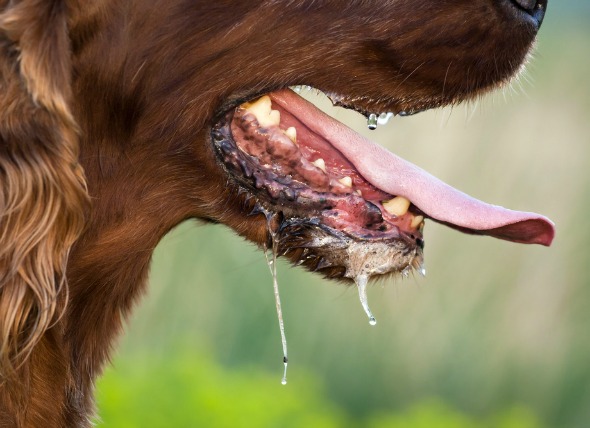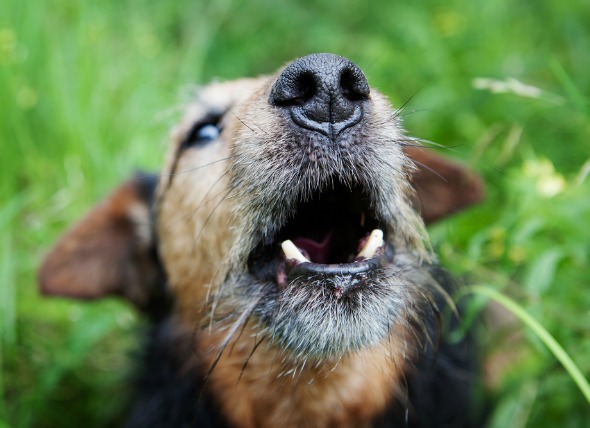

Ptyalism is a condition characterized by the excessive flow of saliva, also referred to as hypersalivation. Pseudoptyalism (i.e., false ptyalism), on the other hand, is the release of excess saliva that has accumulated in the oral cavity. Saliva is constantly produced and secreted into the oral cavity from the salivary glands. Production of saliva increases because of excitation of the salivary nuclei in the brain stem. The stimuli that lead to this are taste and touch sensations involving the mouth and tongue. Higher centers in the central nervous system can also excite or inhibit the salivary nuclei. Lesions involving either the central nervous system or the oral cavity can cause excessive salivation as well. Diseases that affect the pharynx, esophagus, and stomach can also stimulate excessive production of saliva. Conversely, normal saliva production may appear excessive in animals with an anatomic abnormality that allows saliva to dribble out of the mouth, or are affected with a condition that affects swallowing. Ingestion of a toxin, a caustic agent, or a foreign body can also lead to ptyalism.
Young dogs are more likely to have a form of ptyalism caused by a congenital problem such as a portosystemic shunt. Under normal conditions, the portal vein enters the liver and allows toxic components of the blood to be detoxified by the liver. When a shunt is present, the portal vein is inappropriately connected to another vein, which causes blood to bypass the liver. Yorkshire terriers, Maltese, Australian cattle dogs, miniature schnauzers, and Irish wolfhound breeds have a relatively higher incidence of congenital portosystemic shunts. Enlargement of the esophagus is hereditary in wirehaired fox terriers and miniature schnauzers, and familial predispositions have been reported in the German shepherd, Newfoundland, great Dane, Irish setter, Chinese shar-pei, greyhound, and retriever breeds. Congenital hiatal hernia has been recognized in the Chinese shar-pei. Giant breeds, such as the St. Bernard and the mastiff, are known for excessive drooling.
There are many different causes for excessive salivation. You will need to give a thorough history of your dog's health, including vaccination status, current medications, possible toxin exposure, a background history of symptoms, and any other possible incidents that might have precipitated this condition. Your doctor will need to distinguish between hypersalivation associated with a condition that is causing difficulty swallowing, from hypersalivation associated with nausea. Depression, lip smacking, and retching are some of the signs your veterinarian will look for. Your doctor will also want to give your dog a complete physical examination, with special attention paid to the oral cavity and neck, along with a neurologic examination. Diagnostic tools may include x-ray and ultrasound imaging to determine whether there is a problem in the structure of the liver, or in any other internal organs. If an immune-related disorder is suspected, your veterinarian may also want to conduct a biopsy of tissue and cells.
Treating the underlying cause of the ptyalism, once it has been effectively diagnosed, will be the first concern. Although it is generally not necessary, your doctor may also treat the outward symptoms to reduce the flow of saliva. Nutritional supplements may be recommended if your dog has been suffering from ptyalism for any length of time and has not been able to eat properly.
Depending on the underlying cause, your veterinarian will want to monitor your dog as often as necessary to make certain that the treatment plan is working.
 Intestinal Viral Infection (Rotavirus) in Dogs
Rotavirus Infections in Dogs
The double-stranded,
Intestinal Viral Infection (Rotavirus) in Dogs
Rotavirus Infections in Dogs
The double-stranded,
 Liver Inflammation in Dogs
Cholangitis-Cholangiohepatitis Syndrome in Dogs
I
Liver Inflammation in Dogs
Cholangitis-Cholangiohepatitis Syndrome in Dogs
I
 Gallstones in Dogs
Cholelithiasis in Dogs
Cholelithiasis is a medica
Gallstones in Dogs
Cholelithiasis in Dogs
Cholelithiasis is a medica
 Nerve/Muscle Disorder in Dogs
Myasthenia Gravis in Dogs
Myasthenia gravis is a
Nerve/Muscle Disorder in Dogs
Myasthenia Gravis in Dogs
Myasthenia gravis is a
 Collection of Fluid in the Lungs (Not Due to Heart Disease) in Dogs
Noncardiogenic Pulmonary Edema in Dogs
Nonc
Collection of Fluid in the Lungs (Not Due to Heart Disease) in Dogs
Noncardiogenic Pulmonary Edema in Dogs
Nonc
Copyright © 2005-2016 Pet Information All Rights Reserved
Contact us: www162date@outlook.com